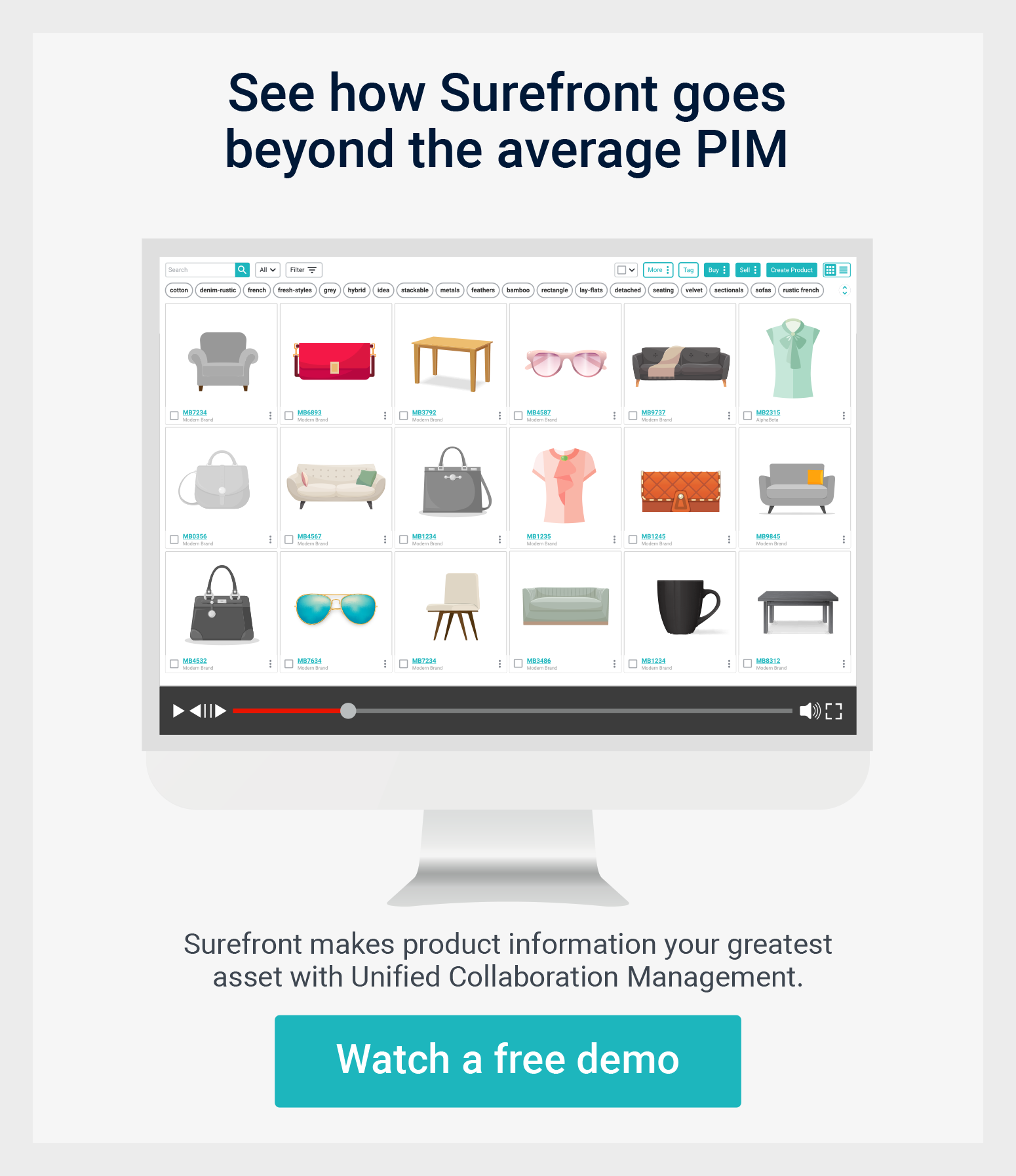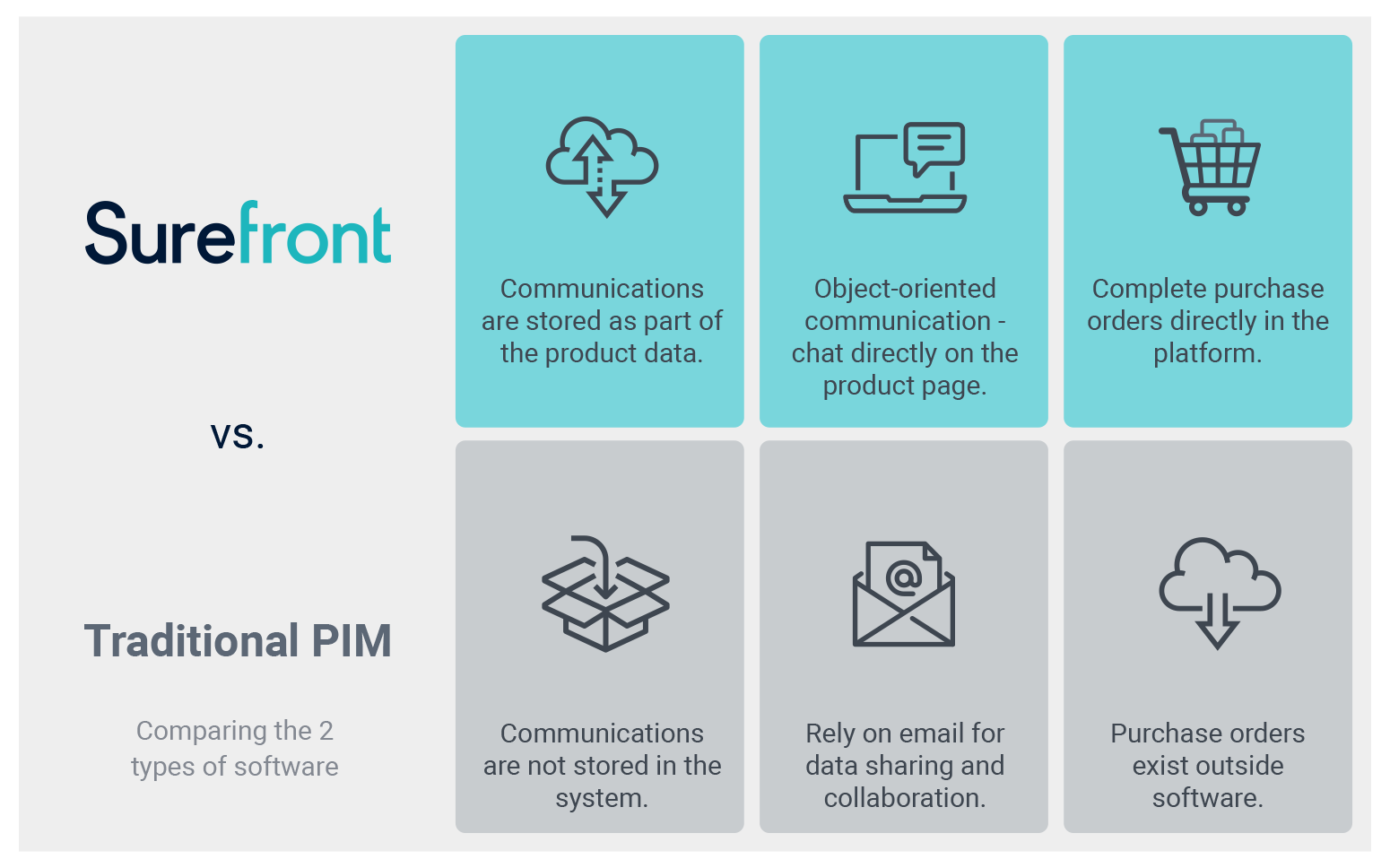Share this
Product Information Management (PIM) Software 101
by Surefront on May 21, 2021 1:44:49 PM
Home > Blog > Part 1: Product Information Management (PIM) Software 101
Table of Contents
- What Information does a PIM Manage?
- Why was PIM Software Created?
- Who Needs PIM Software?
- Syndication and Omnichannel Marketing with PIM
- Traditional PIM vs Surefront
- Bonus Section: How to Properly Sell Your Products to Retailers
Surefront is a Unified Product Collaboration Platform with PIM, CRM, and PLM solutions. It's a centralized data home where stakeholders can freely share product information and assign access permissions. Most integrations are supported in Surefront, but none are needed. Our articles often focus on one aspect of our unified PIM, PLM, and CRM platform. With Surefront, each solution seamlessly works together to achieve a guaranteed 10x ROI for every customer.
PIM software, or “Product Information Management” software, is a technology that centralizes and organizes product information and then distributes it to retailers.
As a product embarks on its journey from manufacturer, to supplier, and is eventually syndicated to retailers, there is a wealth of data that must be collected, organized, and maintained by brands. PIM software serves as the central repository of information for brands to stay organized and efficient in their wholesale (B2B) and retail (B2C) processes, so they can properly manage their catalogs and keep their products up to date with each of their retail channels. This process is also sometimes called “Product Data Management (PDM)” and “Catalog Management.”
In this article, we’ll explore the value of PIM software, advancements in product information management, and how you can transform your product data into your biggest asset. Here’s what we’re covering:
- What Information Does a PIM System Manage?
- Why was PIM Software Created?
- Who Needs PIM Software?
- Syndication and Omnichannel Marketing with PIM
- Traditional PIM vs Surefront
- Bonus Section: How to Properly Sell Your Products to Retailers
What Information Does a PIM System Manage?
To best understand the value of PIM software, we need to first understand what “product information” is, and how this is relevant to a brand’s business.
Generally speaking, “product information” consists of any product specifications and financial data that is relevant to a brand’s wholesale and product development initiatives. This can be anything from sourcing, to design, to marketing, to sales.
Here’s a shortlist of the product information that brands find most relevant to their business initiatives:
- Essential Product Data - SKU’s, UPCs, product names, and descriptions.
- Technical Specifications - measurements, materials, finishes, label content, and warranties.
- Visual Assets - images, videos, and sketches.
- Marketing Data - keywords, SEO research, and buyer personas.
- Sales Information - prices, landed costs, and FOB shipping terms.
- Customer Information - testimonials, reviews, and buyer profiles.
- Design Specifications - style sheets, design notes, and assembly instructions.
- Channel-Focused Information - descriptions and specifications for specific retail channels/mobile versions for eCommerce.
- Localized Data - copy variations and translations.
- Supplier/Factory Data - raw product specifications, certifications, and inventory data by channel.
Product information management software helps centralize, organize, and improve shareability for these types of data across teams. This makes for a higher degree of accountability and efficiency when it comes to leveraging these pieces of information for sales, product development, or marketing initiatives.
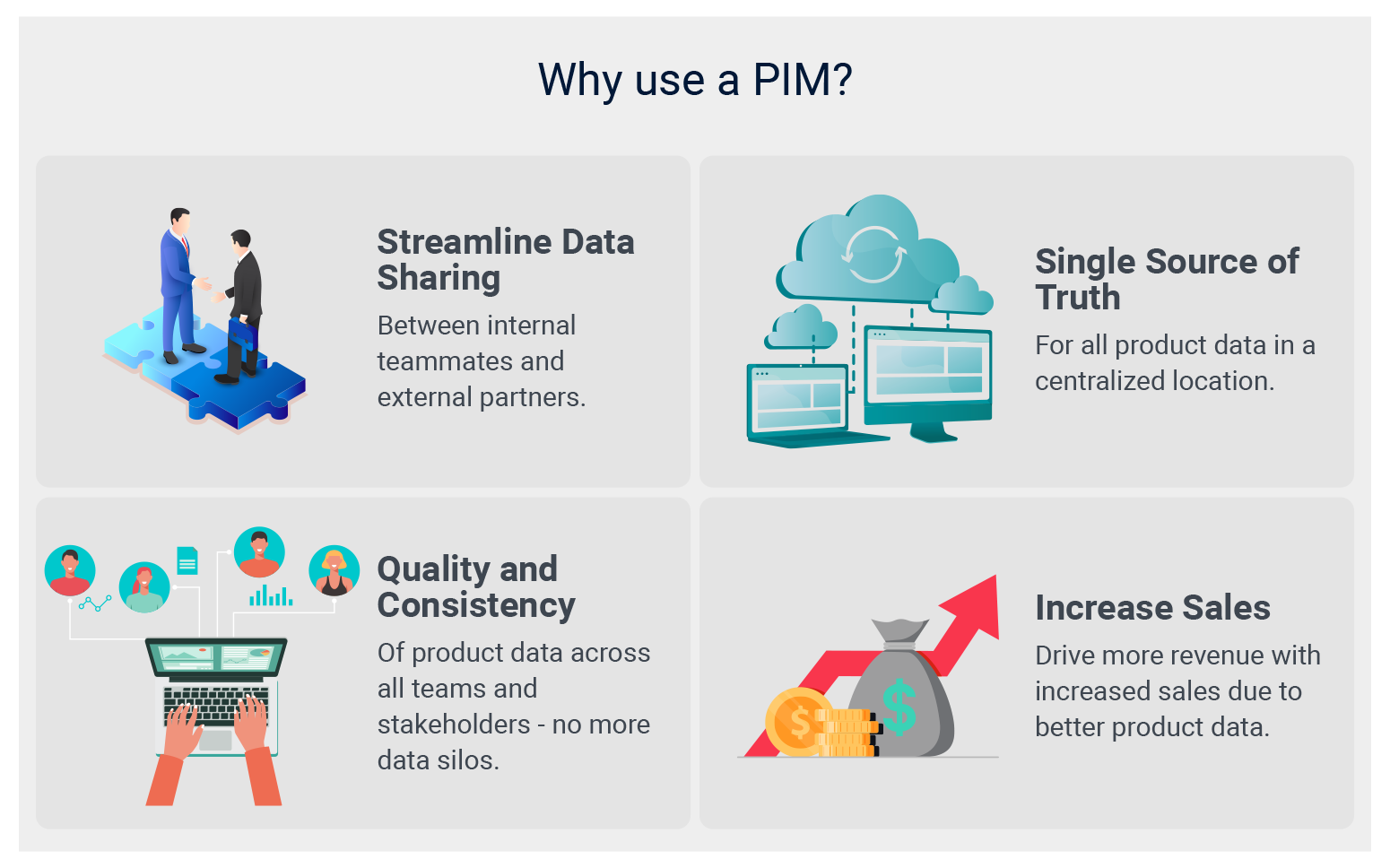
Teams can use the data in their PIM system to track progress and product completion, centralize and clean scattered data, manage relationships between products, and better analyze product performance.
Why was PIM Software Created?
Over the last decade, eCommerce has been one of the fastest growing industries. From 2010 to 2020, eCommerce grew from representing just over 7% of retail sales to exceeding 16% of the industry’s sales. That means more brands sourcing more product from their suppliers and, in turn, syndicating countless SKUs to their retail channels. With more products moving to eCommerce platforms than ever before, brands need new solutions for managing data and publishing the right enriched product information to these various platforms, each with its own set of requirements.
PIM software was built as a means for brands to simplify their work and help with e-commerce business in particular. Any good PIM system should help brands in at least these 5 areas:
- Importing product data - Taking raw data from different sources and importing that data into your central catalog is a critical function of any great PIM system. The software should facilitate the addition of SKUs en masse along with all the relevant specifications and data that comes along with each SKU. No matter whether you’re importing from outside ERPs, spreadsheets, or your suppliers’ systems, your PIM should streamline and automate the process.
Surefront features a Bulk Upload process for up to 10,000 products at once. That takes the workload and time sink of individually uploading those products off your team’s plate and frees up more time for other growth initiatives for merchandising teams and eCommerce managers. - Organizing and classifying information - Any good PIM software should give you the ability to organize your data in the method that works best for your teams. This should include Graphical User Interfaces (GUIs) that eliminate the need for endless lines on spreadsheets that end up being useless.
Another key feature within Surefront that improves upon this important function of a common PIM system is the Bulk Edit feature. This allows you to edit product information on up to 10,000 items all at once, saving the time and effort of individually addressing each product. - Enriching, revising, and translating product information - Enriching product data entails adding all product specifications, detailed descriptions, images and other visual media to your product data. The better enriched your products are with the most accurate aggregated data, the better your products will perform when later syndicated to your retail channels. PIM software should help your team store and organize the best product information for each SKU, and revise/translate that information when needed.
- Facilitating data sharing and better workflow - As a PIM provides centralized storage of your important product data, it should also allow you to better access and share that data. Rather than keeping data in disparate locations, like individual drives and spreadsheets, you’ll have all your product information in one place. With cloud access, all team members can retrieve the data they need without having to export and email files over and over again.
- Syndicating data to retail channels - One of the biggest challenges for a brand’s eCommerce team is to manage and publish products to their various retail channels, as well as synchronize inventory data across these various channels. If you are looking for a great solution for automating this process, PIM software is designed to help. Your PIM system should help you take product information from your manufacturers and automatically format it to the requirements of your retail channels. More on this below.
All of these specific reasons for PIM software's existence point to one simple and ubiquitous notion across the industry: the brands with the best product information will sell the most. This applies to the B2C performance of the products on eCommerce websites. Better product information will always win for the consumer. But that also means a higher demand from your retailers and a bigger opportunity for more B2B sales to your retail partners. For more tips on how to effectively sell more and bring products to market faster, check out our merchandising management blog.
Who Needs PIM Software?
Product Information Management (PIM) software is the connective thread between various teams within a brand. Rather than keeping their data in silos, spread across different teams and individuals, PIM software gives users a single source of truth for their information, no matter their role in the organization.
Here’s who needs a PIM solution within a brand’s organization:
- Omnichannel Marketers - Omnichannel marketing thoughtfully targets customers from their first touchpoint with a product to the very end. This can be all the way from a targeted advertising campaign that uses SEO elements to get in front of the right audience, to on-page copy and graphics for their conversion page and more. Omnichannel marketers use enriched data stored in their PIM system for their marketing initiatives.
- Sales Teams - A brand’s sales team should leverage data stored within the PIM system to better negotiate sales and close deals. With all product specifications and financial information on hand, sales teams can better coordinate internally and communicate key information to retail partners for sales.
- eCommerce Managers - Publishing products to eCommerce channels is only a part of what an eCommerce manager does. Automated product syndication is a function that helps free up time for eCommerce teams to help extend their reach and explore new avenues for growth, otherwise they have to sink their time into manually enriching product information and uploading them individually to their retailers’ eCommerce platforms.
- Data Governance Teams - Data governance teams ensure that a business policies and processes for collecting, processing, distributing, integrating, storing, using data (among other functions). This is to ensure that an organization has precedents for their procedures to ensure best practices for data health. PIM software provides the facilities to enforce these policies.
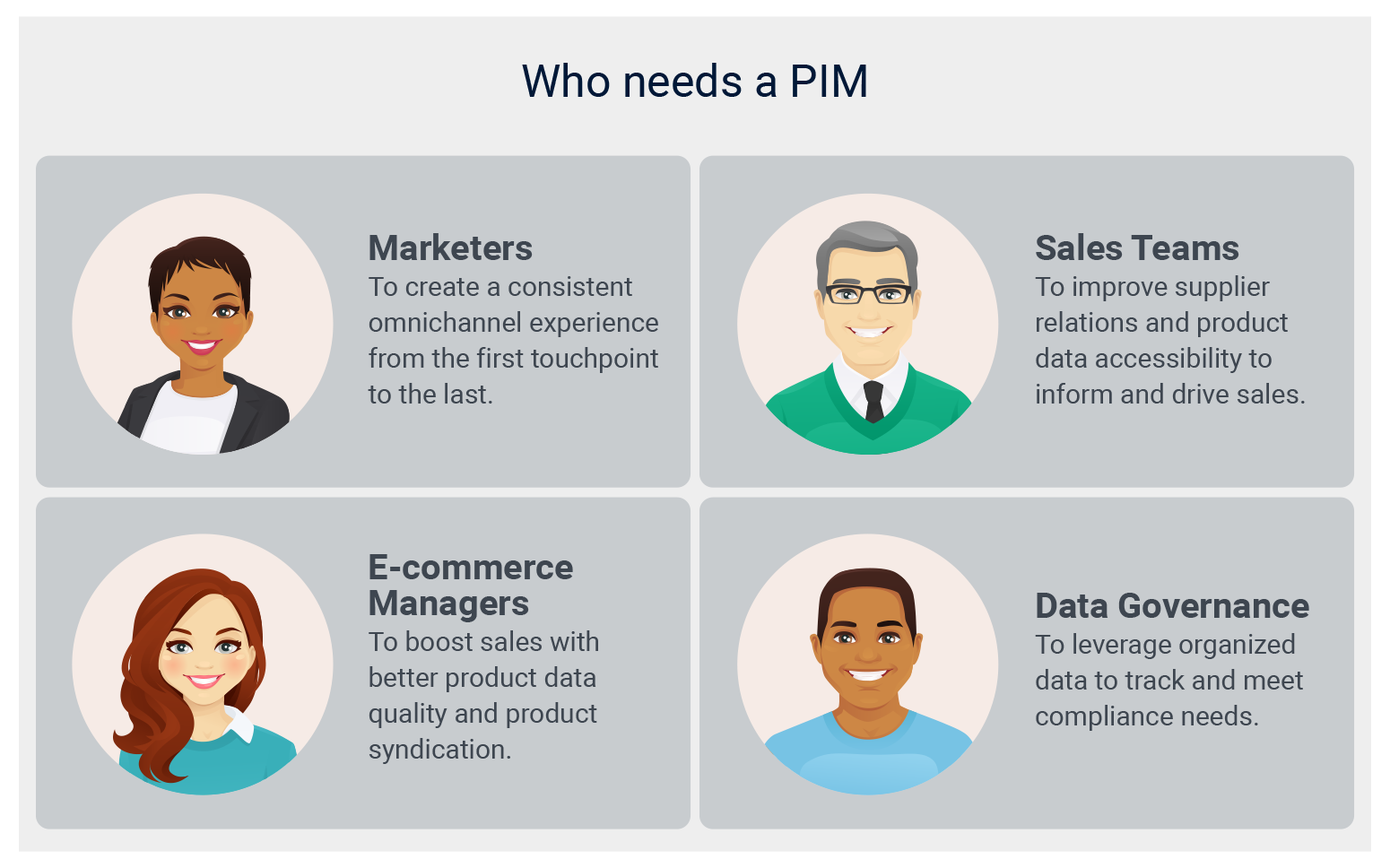
If recent global events have taught us anything, it’s that technology which promotes virtual collaboration and distanced working is invaluable. Modern PIM solutions open the door to better product data accessibility no matter where team members are. This is due to PIM software existing on cloud-based platforms that people can access regardless of their locale.
Syndication and Omnichannel Marketing with PIM
If you stay abreast of the retail industry and technological advancements in the space, you’ve no doubt heard of “product syndication” and “omnichannel marketing.” But, what exactly do those terms mean? How are they connected to product information? And how does PIM software help a brand with these initiatives?
First, let’s talk about e-commerce product syndication. Before shoppers are able to sift through a nearly endless array of products on the largest retailers’ eCommerce sites, the products have to be uploaded with the right information for each retailer. If you’re an eCommerce manager for a brand, you know how painstaking this process can be if your team is manually uploading each SKU individually.
eCommerce syndication is a way of automating this process. Rather than enriching your product data with the right specs, descriptions, and visuals for each of your retail channels, one-by-one, syndication tools within PIM software allow you to format once for your retailers and automatically broadcast your products to them. This is made possible by all of the relevant product data living in one place and being pulled into the given format. This saves eCommerce teams countless hours of manual data entry when managing their accounts.
On the marketing side of things, omnichannel marketing teams need a way to create consistency throughout their messaging. They need to create marketing messages and tones that maintain continuity through a variety of platforms including: in-store advertising, messaging across websites, mobile apps, catalogs, and social media.
Omnichannel marketers main goal is to create a seamless experience for their target audience throughout each of these touchpoints to help convert them into customers. Organized, accessible data within a PIM system is key to the success of omnichannel marketing campaigns. Continuity within product information leads to continuity in marketing those products.
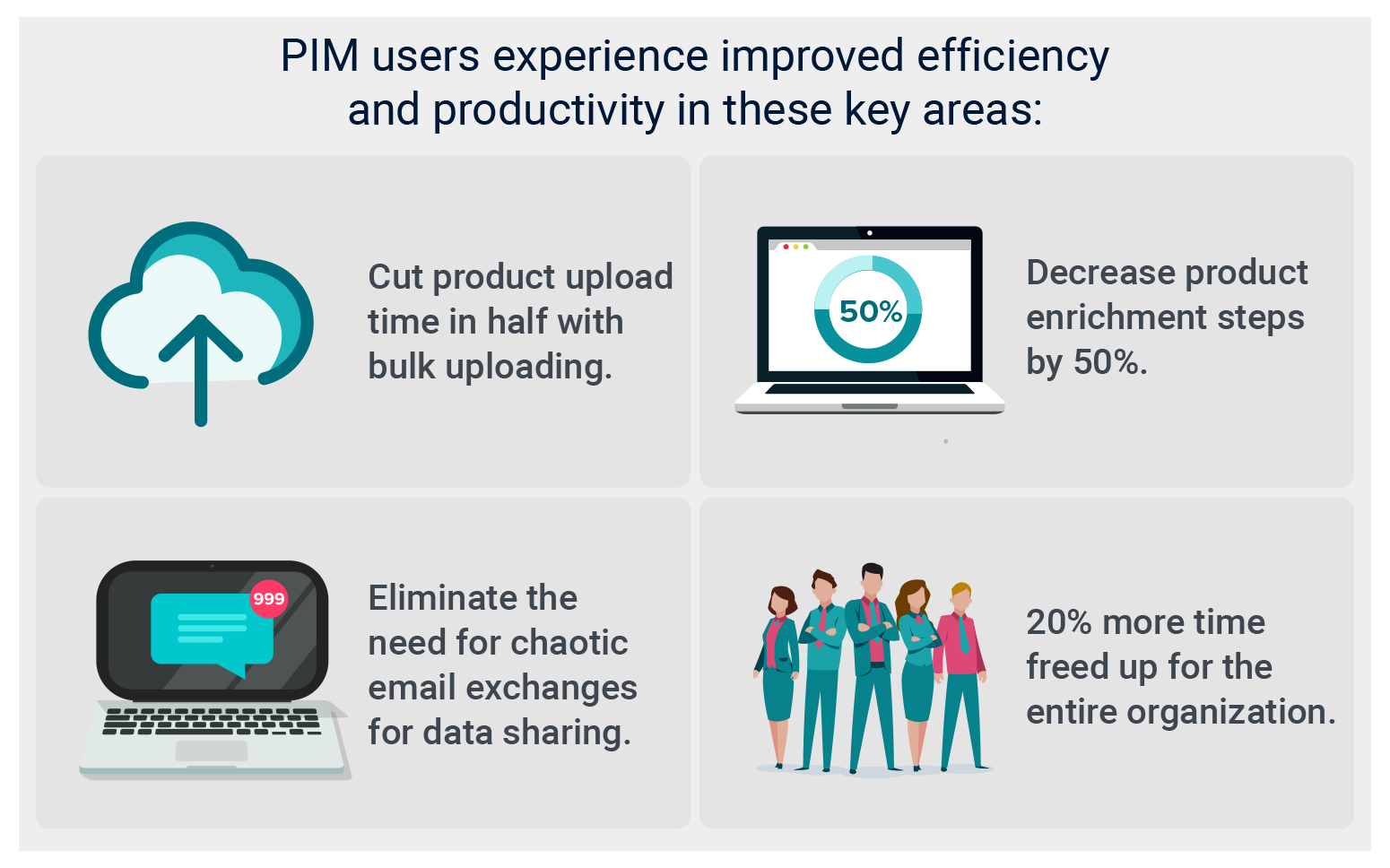
Traditional PIM vs Surefront
Surefront performs the best functions of product information management software, but goes far beyond a traditional PIM solution.
Surefront is classified as a “Unified Product Collaboration Platform." What that means is not only does it unify product data (similar to a PIM) and allow you to syndicate that information to retailers (similar to a PLM), but it also unifies collaboration (that's where CRM comes in). This leads to 5 critical distinctions between Surefront and the average PIM software:
- Communication Becomes Part of Your Data - An integral part of collaboration is communication. Traditional product information management systems do only what their name suggests. They allow you to store, organize, and manage your data. But what about creating that information in the first place and all the communication that happens between stakeholders outside of your system?
You use email with attachments, Slack, and other chat tools, but all of that critical exchange of notes, ideas, and information between stakeholders tends to disappear or stay in these siloed locations, long forgotten. With Surefront, you have a built-in chat with your product details, quotes, and purchase orders. Your communication history becomes a part of your stored data.
The best part is that you can communicate with your internal teammates as well as your external partners, like manufacturers or buyers. Whether they are fully onboarded to Surefront or not, you can invite your 3rd-party collaborators to view showcases, product detail pages, quotes, or purchase orders. With a real-time, live chat on the same page, you have everything you need to conduct your business in a single collaborative space. Additionally, Surefront has a Sticky Notes function that allows you to place individual notes on specific data points, as if you were sticking a real-life note on a collaborative whiteboard.
Surefront integrates all the functionality of a Product Lifecycle Management (PLM) system, Customer Relationship Management (CRM) system, and a PIM system for the most complete product data environment. Learn more our retail software in our blog. - Object-Oriented Communication - With Surefront’s in-platform communication comes a higher degree of sophistication for your product information. The communications that become a key part of your product data are attached to the specific collaboration objects for which they occurred. This includes: products, requests for quotes (RFQs), quotes, purchase orders, and workflows.
This patented method of unifying contextual communications, with each piece of communication tied to specific collaboration objects, brings your team and your external partners closer to the product information at hand. This creates an immersive collaborative experience without the chaos and hassle of cross-referencing emails and other chat tools, whose messages quickly become buried.
This is one of the most cutting-edge pieces of technology that sets Surefront Unified Product Collaboration apart from the average PIM software, CRM software, or PLM software. Unifying product data and communications is an unprecedented move toward a totally comprehensive environment for storing and managing product data, with the means to bring products all the way to market.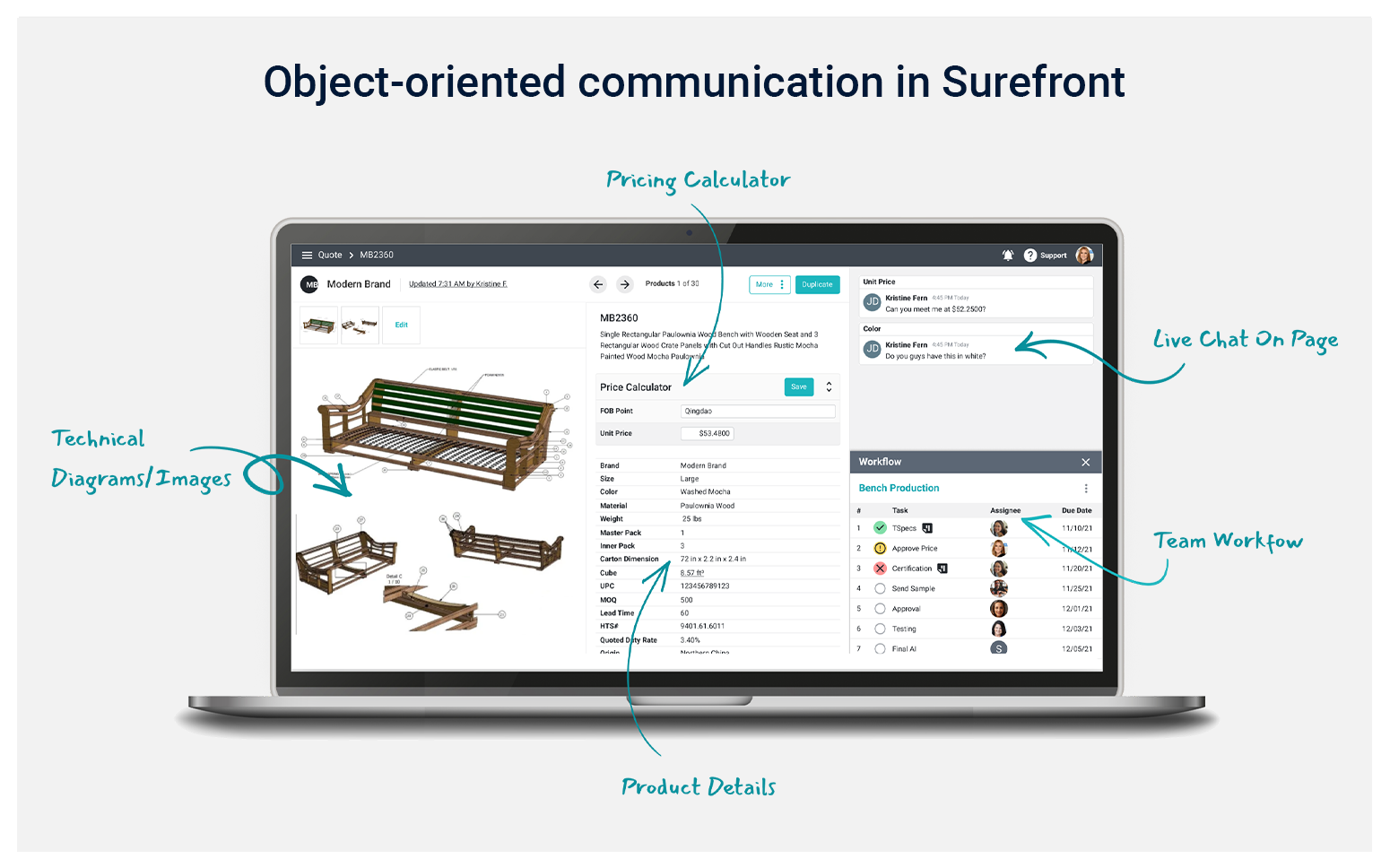
Engaging and managing supplier relationships becomes exponentially easier with these tools at hand to track communications and discussion of individual products and negotiations. To learn more about supplier management, check out our blog with tips for improving 3rd-party relations. - Bring Product All the Way to Market - Surefront takes collaboration to the next level from start to finish of the product journey. This starts with external data coming in from manufacturers. Surefront removes the need and burden of data reentry, which improves data integrity and accuracy. Less time spent on data entry saves time and accelerates speed to market, which translates into better assortment, better sell-through, and better margin.
Unlike traditional PIM systems, Surefront allows you to bring products all the way to market. That means you can create quotations for your buyers right in the app that provides a visual reference of your product along with all the product information that’s relevant for your audience.
Traditional PIM software does not allow you to engage your suppliers and your retail partners on a personal level. Outside of product syndication, you are left to emails and spreadsheets to communicate with buyers. This is insufficient for scaling your business and streamlining the process for your sales team.
Within Surefront, you have complete control over the data that your 3rd-party partners can see. Surefront's PIM informs your B2B Customer Relationship Management (CRM) platform for instant selected data access for stakeholders. This keeps all sensitive financial information private to your team while providing the flexibility to share what you choose with whomever you wish.
Surefront unites PIM, CRM and PLM tools and allows you to bring products to market with functionality that goes well beyond the simplicity of internal team collaboration. Read more about merchandising software here. - Custom Product Syndication - Though one of the hallmarks of a good PIM system is product syndication, no one quite has the formula for success like Surefront. Where other PIMs provide cookie-cutter templates for syndication, Surefront is all about getting the process perfectly tailored to your needs from the start; it’s the most flexible solution for your eCommerce needs.
With traditional PIMs, you are often subjected to preset formats for eCommerce syndication that only cover the largest and most common retailers’ requirements. If you have other retail channels outside of those select few, you are left with no support from your PIM software.
With Surefront, you get a tailored syndication experience with a customer success team that will create custom eCommerce sheets during the onboarding process. As requirements from your retail channels change and evolve, so too will your custom sheets as Surefront’s customer success team stays at your disposal, ready to adjust your syndication templates. Regardless of the volume or stature of your retail partners, Surefront will support your eCommerce needs. - The right data in the right format, every time - One of the biggest challenges eCommerce managers and merchandisers face is having the right data in the right format for their various channels. Retailers like Wayfair can have multiple different formats with various requirements just for one segment or category of their offerings. This can be a massive challenge for eCommerce managers who rely on individual data entry or cookie-cutter syndication tools.
Surefront solves this issue by providing custom formatting that meets the exact requirements of your sales channels. Whether you’re working with a retailer that keeps it simple with one general product format or you’re selling to a retailer that has five different formats just for sofas, Surefront allows for the flexibility you need.
Another problem that eCommerce teams face is constantly-changing product requirements and formats from their retail partners. This is another area where Surefront’s flexibility in data formatting fits the bill.
Surefront ensures that you have the data you need, in any form you need, in a timely manner. The platform allows for customizable data exports with the ability to generate customizable line sheets, quote sheets, internal catalog sheets, and other ad hoc worksheets. These exports can be mapped to any file format to fulfill exactly what you need to deal with retail channels or internal processes.
Bonus Section: How to Properly Sell Your Products to Retailers
Retailers prefer when you use Surefront's unified platform over a traditional PIM system. Your ability to easily curate the ideal showcases and quotes for them makes for a better experience when negotiating prices, engaging in product customization, and finalizing deals. Buyers who have experienced Surefront’s Unified Product Collaboration Platform have unanimously agreed that communication is far easier and more effective than email. As a brand who wants to sell more to your retailers, it behooves you to leverage Surefront’s added values for your retail partners.
Surefront allows retailers to better manage their categories. For more on category management, read our blog that gives the full rundown on how retailers use a category-oriented method of procurement to drive growth and perfect their assortments.
Whether you’re operating on the buying (retailer) side, or the supplier (brand) side of things, Surefront provides everything you need to efficiently and effectively bring products to market.
You don’t want your data to be siloed. Your company’s CRM, PIM and PLM solutions shouldn’t operate in a vacuum, either. Surefront is a unified product collaboration platform to power growth and ROI. Our patented PIM, CRM, and PLM solutions streamline the omni channel sales, merchandising and product development processes. By combining these essential functionalities, Surefront creates a single source of truth throughout your product lifecycle, sales and listing processes.
The results? Up to 150% more revenue per employee and a 40% shorter product development cycle is just the beginning. Try our 10x ROI calculator to see your company’s potential profits. Or, skip the noise and book a custom demo with one of our unified product collaboration management experts today. The retail industry evolves quickly and has a lot of moving parts. We do all of the research, so you don’t have to. Stay ahead of market fluctuations, trends and new features by subscribing to our Unified Product Collaboration Management Blog.
Share this
- PLM Software (35)
- PIM Software (29)
- Trending Topics (20)
- Apparel & Fashion (14)
- CRM Software (14)
- PLM Implementation (9)
- Merchandising (6)
- Tech Packs (6)
- Catalog Management (5)
- PLM RFP (5)
- Success Stories (5)
- Sustainability (5)
- Line Sheet (4)
- Luxury Goods & Jewelry (4)
- Product Development (4)
- Retail (4)
- Supply Chain (4)
- Category Management (3)
- Data Import (3)
- Home Furnishings (3)
- Wholesale (3)
- Consumer Packaged Goods (CPG) (2)
- Cosmetics (2)
- Data Export (2)
- Health & Beauty (2)
- Industry Events (2)
- RFQ & Quote Management (2)
- Consumer Electronics (1)
- Import & Export (1)
- Inventory Management (1)
- Pet Stores (1)
- Purchase Orders (1)
- Report Builder (1)
- Textiles & Raw Materials (1)
- Unified Solution (1)
- Vendor Management (1)
- White Paper or Case Study (1)
- March 2025 (3)
- January 2025 (8)
- December 2024 (5)
- November 2024 (3)
- October 2024 (5)
- September 2024 (6)
- August 2024 (2)
- July 2024 (1)
- June 2024 (3)
- May 2024 (4)
- April 2024 (5)
- March 2024 (3)
- February 2024 (2)
- December 2023 (4)
- September 2023 (2)
- August 2023 (5)
- July 2023 (3)
- June 2023 (2)
- May 2023 (2)
- April 2023 (4)
- March 2023 (5)
- February 2023 (3)
- January 2023 (5)
- December 2022 (4)
- November 2022 (3)
- October 2022 (4)
- September 2022 (5)
- August 2022 (4)
- July 2022 (3)
- June 2022 (1)
- May 2022 (1)
- February 2022 (1)
- January 2022 (1)
- September 2021 (1)
- May 2021 (1)
- April 2021 (1)
- February 2021 (1)
- December 2020 (1)
- May 2020 (1)
